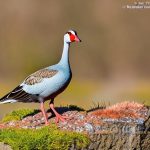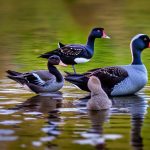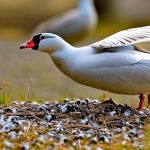Sebastopol Geese are a unique and beautiful breed of domestic geese that are known for their curly feathers. They are a popular choice for breeders due to their striking appearance and friendly temperament. In this article, we will explore the history of Sebastopol Geese, their characteristics, how to select the right breeding stock, preparing for breeding season, incubation and hatching, caring for goslings, raising Sebastopol Geese for meat or show, common health issues, and tips for successful breeding.
Key Takeaways
- Sebastopol Geese are a unique and beautiful breed with curly feathers.
- They were originally bred in Europe and brought to the United States in the 1800s.
- When selecting breeding stock, look for healthy birds with good feather quality and temperament.
- Breeding season typically begins in late winter or early spring, and incubation takes about a month.
- To prevent common health issues, provide clean water and a balanced diet, and keep the birds in a clean environment.
The History of Sebastopol Geese
Sebastopol Geese originated in the region of Sevastopol in Crimea, which is now part of Ukraine. They were developed in the early 19th century by crossing domestic geese with wild greylag geese. The goal was to create a breed with unique feathering patterns and a friendly temperament.
The breed was further developed in Europe, particularly in Germany and France, where breeders focused on refining the curly feathering. Sebastopol Geese were primarily used for ornamental purposes due to their striking appearance. They were often kept in parks and gardens as decorative birds.
Characteristics of Sebastopol Geese
Sebastopol Geese are known for their unique appearance. They have long, curly feathers that give them a fluffy and elegant look. Their feathers can come in various colors, including white, gray, and buff. The curly feathers are more pronounced in males than females.
In terms of temperament, Sebastopol Geese are known to be friendly and docile. They are not aggressive and can be easily handled. This makes them suitable for families with children or individuals who want a calm and sociable breed.
One of the most unique traits of Sebastopol Geese is their ability to molt their feathers twice a year. During molting, they shed their old feathers and grow new ones. This process can take several weeks and can leave the geese looking bare and vulnerable. However, their feathers will grow back in their characteristic curly pattern.
Selecting the Right Breeding Stock
When selecting breeding stock, it is important to choose birds that meet the breed standard and have desirable traits. Look for geese with well-defined curly feathers, good body conformation, and a friendly temperament. Avoid birds with any physical deformities or signs of illness.
It is also important to consider genetic diversity when selecting breeding stock. Inbreeding can lead to health issues and reduced fertility in the offspring. Therefore, it is recommended to introduce new bloodlines into your breeding program periodically to maintain genetic diversity.
Preparing for Breeding Season
Sebastopol Geese typically breed in the spring, so it is important to prepare for the breeding season in advance. Create a suitable breeding environment by providing nesting boxes or shelters for the geese. These should be clean, dry, and well-ventilated.
Feeding and nutrition are also crucial during the breeding season. Provide a balanced diet that includes a mix of grains, greens, and protein sources. Supplement their diet with calcium-rich foods such as crushed oyster shells to support egg production.
Incubation and Hatching

Sebastopol Geese eggs take about 28-34 days to hatch. If you do not have a broody goose to incubate the eggs, you can use an artificial incubator. Set the temperature to around 99-100 degrees Fahrenheit and maintain a humidity level of around 50-55%.
Turn the eggs at least three times a day during the incubation period to prevent the embryos from sticking to the shell. Candle the eggs after about a week to check for fertility and remove any infertile eggs.
Once the goslings start hatching, it is important to provide them with a warm and safe environment. Use a brooder box with a heat lamp to maintain a temperature of around 95 degrees Fahrenheit for the first week. Provide clean water and a balanced starter feed specifically formulated for goslings.
Caring for Goslings
Feeding and nutrition are crucial during the early stages of gosling development. Provide a balanced diet that includes a mix of starter feed, greens, and protein sources. Gradually introduce them to foraging as they grow older.
Housing and environment are also important for the well-being of goslings. Provide a clean and spacious brooder box or pen with enough room for them to move around. Make sure the bedding is clean and dry to prevent any health issues.
Common issues with goslings include pasty butt, which is a condition where feces stick to the vent area and can cause blockage. To prevent this, regularly check their vents and clean them if necessary. Also, keep an eye out for any signs of illness or injury and seek veterinary care if needed.
Raising Sebastopol Geese for Meat or Show
Sebastopol Geese can be raised for both meat and show purposes. If you are raising them for meat, it is important to provide them with a balanced diet that includes a mix of grains, greens, and protein sources. Allow them access to pasture or free-range areas to encourage natural foraging behavior.
If you are raising Sebastopol Geese for show, it is important to select birds that meet the breed standard in terms of appearance and conformation. Regular grooming and maintenance of their curly feathers are necessary to keep them in top show condition.
When it comes to processing meat birds, it is important to do so humanely and in accordance with local regulations. Seek guidance from experienced breeders or professionals in your area to ensure proper processing techniques.
Common Health Issues and How to Prevent Them
Sebastopol Geese are generally hardy birds, but they can still be susceptible to certain health issues. Common health issues in Sebastopol Geese include respiratory infections, parasites, and foot problems.
To prevent respiratory infections, provide a clean and well-ventilated environment for your geese. Regularly clean their living quarters and provide fresh bedding. Avoid overcrowding, as this can increase the risk of disease transmission.
Parasites such as mites and worms can be prevented through regular deworming and the use of appropriate parasite control products. Keep an eye out for any signs of infestation, such as feather loss or weight loss, and seek veterinary care if necessary.
Foot problems can be prevented by providing a clean and dry environment for your geese. Regularly check their feet for any signs of injury or infection. Trim their nails if necessary to prevent overgrowth.
Conclusion and Tips for Successful Breeding
Breeding Sebastopol Geese can be a rewarding experience for both beginners and experienced breeders. By selecting the right breeding stock, preparing for the breeding season, providing proper care during incubation and hatching, and addressing common health issues, you can increase your chances of successful breeding.
Remember to always prioritize the well-being of your geese and provide them with a suitable environment, proper nutrition, and regular veterinary care. With patience and dedication, you can enjoy the beauty and companionship of these unique birds. So why not give breeding Sebastopol Geese a try?
If you’re interested in breeding Sebastopol geese, you may also want to check out this informative article on the mating season for turkeys. Understanding the mating habits and behaviors of turkeys can provide valuable insights into successfully breeding other poultry species. To learn more, click here: https://poultrywizard.com/breeding-turkey/mating-season-for-turkeys/.
FAQs
What are Sebastopol geese?
Sebastopol geese are a breed of domesticated geese that are known for their curly feathers. They are believed to have originated in Europe, specifically in the region of Pomerania.
What is the breeding process for Sebastopol geese?
Breeding Sebastopol geese involves selecting healthy and genetically diverse breeding pairs. The geese are then allowed to mate naturally, and the eggs are incubated for about 28-34 days until they hatch. The goslings are then raised until they are mature enough to breed.
What are the ideal conditions for breeding Sebastopol geese?
Sebastopol geese require a clean and spacious environment with access to fresh water and food. They also need protection from predators and extreme weather conditions. Breeding pairs should be kept in separate enclosures to prevent fighting and ensure proper mating.
What is the lifespan of Sebastopol geese?
Sebastopol geese can live up to 10-15 years if they are well-cared for and kept in a healthy environment.
What are the benefits of breeding Sebastopol geese?
Breeding Sebastopol geese can provide a source of income through the sale of goslings, eggs, and meat. They are also known for their ornamental value and can be kept as pets or for exhibition purposes. Additionally, they are hardy birds that are relatively easy to care for.
Meet Walter, the feathered-friend fanatic of Florida! Nestled in the sunshine state, Walter struts through life with his feathered companions, clucking his way to happiness. With a coop that’s fancier than a five-star hotel, he’s the Don Juan of the chicken world. When he’s not teaching his hens to do the cha-cha, you’ll find him in a heated debate with his prized rooster, Sir Clucks-a-Lot. Walter’s poultry passion is no yolk; he’s the sunny-side-up guy you never knew you needed in your flock of friends!







